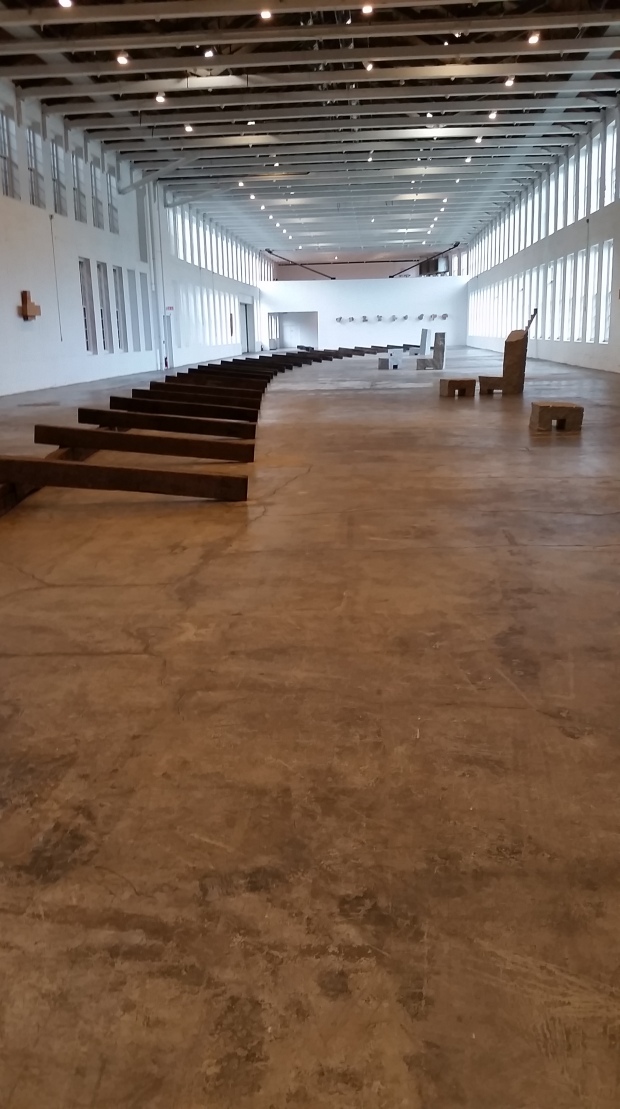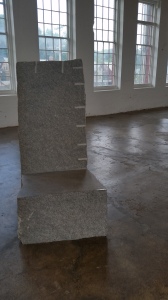Richard Nonas’ “The Man in the Empty Space” is an exibition intended to “fundamentally alter our sense of space, time, landscape, and architecture.”
Sound is space and time, and we can use sound placed within constructed-space (architecture) to explore how we sense place.
This is a sonic meditation about presence.
Sonic Meditations are pieces that expand our awareness of the world through sound. Their aim is to promote curiosity and ” focus our attention on how listening is an act of cognition that can “filter” or shape auditory perception.” – William Osbourne
You can learn more about them here:
In this Sonic Meditation, the listener brings his or her cellphone (or a small personal speaker) into the space and plays pink noise. The pink noise is absorbed and reflects off each surface in a unique way. I explore this space using noise because noise amplifies our innate ability to hear space.
“Noise was traditionally regarded as a nuisance, which should be minimized if possible. However, recent research has shown that addition of an appropriate amount of noise can actually improve signal detection in a nonlinear system” – FG Zeng Human Hearing Enhanced by Noise
In this meditation, the ear is our nonlinear system. By playing pink noise through your phone speaker and pointing it in certain places, we can amplify our ability to hear how materials (wood, brick, glass, cement) and texture (flat, complex, square, rough, smooth) absorb parts of the noise spectrum and help us form an image of this space in our minds.

The goal in this Sonic Meditation is to reflect on our ability to use these subtle cues to sense the physical and material characteristics of the world. This almost bat-like ability is largely ignored in our everyday life.
I have outlined a few places that were interesting to me while doing this practice alone in the gallery, but there are an infinite number of ways this space can ring. I have included them as a guide to get started. I have taken a panorama of each place I have chosen to help you find the places that resonated with me. I hope they will resonate with you, too.
The first step in this meditation is to read the pamphlet about the installation located at the start of the installation. This will focus your attention, teach you about the exhibition, and contextualize the space.
It is important to move slowly and point the pink noise in a direction the allows you to pick up on the space.
This will be unique to you. Feel free to wave the noise around until you find the ideal position to hear the surfaces you seek to explore. Feel free to try this with others.
Notice how many things you can hear. It is almost like you can see!
Here is a link to a 10-minute clip of pink noise, but you can use your own pink noise generator if you have one available:
Here are some example of the kinds of echoes you may hear:
1. wood: high frequencies dampened, a ‘warm’ echo
2. Flat Cement Floor: a lot of echo (many high frequencies/ inharmonic to sung tones)
3. Glass: high frequencies. very directional.
4. Granite Chairs: echoes on the flat surfaces/ dissipation on the rough surfaces/ blocking the echoes of the walls
I. Chairs

Begin by facing the chair below (look out the windows to figure out which chair and how far away to stand). Direct your noise and attention to the chair and then slowly work your way to the floor. Point your noise at the glass windows and slowly direct the sound down to the floor and then the wood. Listen to how these surfaces reflect. If you close your eyes, could you navigate the space using these clues?

Try facing the ladder and working your way towards it with your eyes closed (do this very carefully!!!). Can walk to the ladder?
Now, walk towards the back of the room. Point your noise at the ceiling. Where does it reflect the most?
You can explore each of the chairs in this way (and each side of each chair)
II. Wood and Walls
Find this place within the wooden sculpture– preferably through listening. At this place, I was drawn to the sound of the windows. Compare this to the wall, the floor, and the pieces of wood at your feet. Can you hear their tin ring? The warm echo of the wood?
You can walk along the wooden sculpture to see where it resonates the best for you.
III. Liminal Space
Here we focus on the contrast of the close space of the smaller gallery with the large open room. Using your noise, can you find the exact place where you can hear the small room become the large one? How precisely can you locate this spot?
IV. Walls

Using your noise like a laser beam, sweep it across the wall. Listen the texture of the wall.